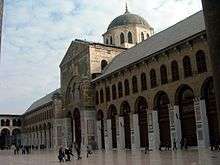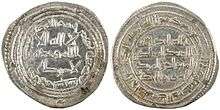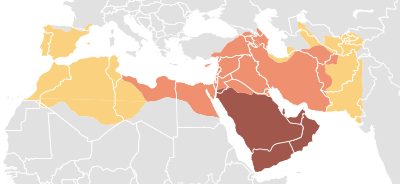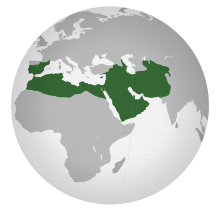Al-Walid I
| Al-Walid ibn Abd al-Malik الوليد بن عبد الملك | |||||
|---|---|---|---|---|---|
 Al-Walid ibn Abd al-Malik rendered in Arabic calligraphy | |||||
| Caliph of the Umayyad Caliphate | |||||
| Reign | 8 October 705 – 23 February 715 | ||||
| Predecessor | Abd al-Malik ibn Marwan | ||||
| Successor | Sulayman ibn Abd al-Malik | ||||
| Born |
668 Medina | ||||
| Died | 23 February 715 (aged 47) | ||||
| Issue | Abd al-Aziz, Yazid III, Ibrahim, al-Abbas | ||||
| |||||
| House | Banu Abd Shams | ||||
| Dynasty | Umayyad | ||||
| Father | Abd al-Malik ibn Marwan | ||||
| Mother | Walladah bint al-Abbas al-Ghatafaniyyah[1] | ||||
Al-Walid ibn Abd al-Malik (Arabic: الوليد بن عبد الملك) or Al-Walid I (668 – 23 February 715) was an Umayyad Caliph who ruled from 705 until his death in 715. His reign saw the greatest expansion of the Caliphate, as successful campaigns were undertaken in Transoxiana in Central Asia, Sind, Hispania in far western Europe, and against the Byzantines. He poisoned the fourth Shi'a imam, Zayn al-Abidin.[2][3]
Biography
Walid was born in Medina in 668 to Abd al-Malik ibn Marwan. Walid's mother was from the Nejdi tribe of Banu Abs a subtribe of Banu Ghatafan. Walid continued his father's expansion of the Islamic empire and was an effective ruler. His father Abd al-Malik had taken the oath of allegiance for Walid during his lifetime.[4]. As such the succession of Walid was not contested. His reign was marked by a number of conquests in both the east and west with historians considering his reign as the apex of Islamic power.
Sulayman succeeded his brother Walid after he died in 715. He was buried in the Bab al-Saghir cemetery in Damascus. His grave is still present to this date.
Conquests
Walid continued his father's policies of expanding Islamic power through conquests and took the early Islamic empire to its farthest extent. In 711, Muslim armies crossed the Strait of Gibraltar and began to conquer the Iberian Peninsula using North African Berber troops. By 716, the Visigoths of Iberia had been defeated and most of Iberia was under Muslim control and some of present day France. In the east, Islamic armies made it as far as the Indus River in 712. Under Walid, the Caliphate stretched from the Iberian Peninsula to India. Al-Hajjaj ibn Yusuf continued to play a crucial role in the organization and selection of military commanders in the East, serving as effectively the viceroy there.
Walid paid great attention to the development and expansion of a well-organized military. He built the strongest navy of the Umayyad era which was a key element in Caliphate's expansion into Iberia.
Like his father, Walid continued to allow Al-Hajjaj ibn Yusuf free rein, and his trust in Hajjaj paid off with his successful conquests of Transoxiana and Sindh. Musa ibn Nusayr and his retainer Tariq ibn Ziyad conquered Al-Andalus; whilst Mohammad Bin Qasim Conquered Sindh (present day Pakistan). Hajjaj was responsible for picking the generals who led the successful eastern campaigns, and was successful in his campaign against Ibn Zubayr during the reign of Walid's father. Others, such as Walid's brother Maslamah, advanced against the Byzantines and into Adharbayjan.
Muhammad ibn Jarir al-Tabari describes how Qutayba ibn Muslim, Khurasan's governor, led forces extending the Caliphate to the east. Qutayba conquered Samarkand, advanced into Farghana and sent envoys to China. (v. 23)
Al-Tabari records how Hajjaj tortured Yazid ibn al-Muhallab. Yazid escaped and made his way to Walid's brother Sulayman ibn Abd al-Malik who granted him refuge. Hajjaj pressed Walid about this and Walid commanded Sulayman to send him Yazid in chains. Sulayman had his own son approach Walid chained to Yazid and spoke in favour of Yazid's safety. Walid accepted this and told Hajjaj to desist. (v. 23, p. 156f)
Islamic culture and civilization


Walid began the first major building projects of Islam. The history of Islamic architecture can be said to have begun in earnest with Walid. Around 701, al-Walid ordered the building of Al-Aqsa Mosque, opposite his father's Dome of the Rock on the Temple Mount. Walid repaired and refurbished Masjid al Nabawi in Medina. He also improved roads, mountain passes and wells in Hijaz (al-Tabari v. 23, p. 144).
At the site of the Christian Basilica of Saint John the Baptist, he built a mosque, now known as the Great Mosque of Damascus or simply the Umayyad Mosque.[5][6][7][8] The mosque holds a shrine which is said to contain the head of John the Baptist, honored as a prophet by Muslims and Christians alike (he is considered a Prophet of Islam and is known as Yahya). The head was said to have been found during the excavations for the building of the mosque. The tomb of Saladin stands in a small garden adjoining the north wall of the mosque.
Walid coupled Islam with Arabic culture and values. Since non-believers had to pay an extra tax, many people did convert for religious and non-religious reasons. This created several problems, particularly since Islam was so closely connected with being Arab. Being Arab was more than an ethnic identity, it was a tribal identity based on kinship and descent. As more and more Muslims were non-Arabs, the status of Arabs and their culture was threatened. In particular, large numbers of Coptic-speaking (Egypt) and Persian-speaking Muslims threatened the primacy of the very language that Islam was based on. In part to alleviate that threat, Walid instituted Arabic as the only official language of the empire. He decreed that all administration was to be done only in Arabic. It was this move that cemented the primacy of Arabic language and culture in the Islamic world.
Walid built one of the first care homes for intellectually disabled individuals and built the first hospital which accommodated intellectually disabled individuals as part of its services. In addition, Walid assigned each intellectually disabled individual a caregiver.[9]
Sources
- Muhammad ibn Jarir al-Tabari, v. 23 The Zenith of the Marwanid House, transl. Martin Hinds, Suny, Albany, 1990
References
| Wikisource has original works written by or about: Al-Walid I |
- ↑ Dr. Eli Munif Shahla (1998). Al-Ayam al-Akhira fi Hayat al-Kulafa (1st ed.). Dar al-Kitab al-Arabi. p. 236.
- ↑ WOFIS (2001). A Brief History of the Fourteen Infallibles (3rd ed.). Tehran: World Organization for Islamic Services.
- ↑ Donaldson, Dwight M. (1933). The Shi'ite Religion: A History of Islam in Persia and Irak. BURLEIGH PRESS. pp. 101–111.
- ↑ Muhammad and conquests of Islam by Francesco Gabreili
- ↑ Grafman and Rosen-Ayalon, 1999, p.7.
- ↑ Flood, Finbarr Barry (2001). The Great Mosque of Damascus: studies on the makings of an Umayyad visual culture. Boston: BRILL. pp. 1–2. ISBN 90-04-11638-9.
- ↑ C. Rudolph, ed. (2006). "The concept of spolia". A companion to medieval art: Romanesque and Gothic in northern Europe. Oxford: Oxford University Press. p. 177.
- ↑ Takeo Kamiya (2004). "Umayyad Mosque in Damascus, Syria". Eurasia News. Retrieved 31 December 2015.
- ↑ https://www.tandfonline.com/doi/full/10.1080/02673843.2011.649565
Bibliography
- Grafman, Rafi; Rosen-Ayalon, Myriam (1999). "The Two Great Syrian Umayyad Mosques: Jerusalem and Damascus". Muqarnas. Boston: BRILL. 16: 1–15. doi:10.2307/1523262.
Al-Walid I Born: 668 Died: 23 February 715 | ||
| Sunni Islam titles | ||
|---|---|---|
| Preceded by Abd al-Malik ibn Marwan |
Caliph of Islam Umayyad Caliph 705 – 23 February 715 |
Succeeded by Sulayman ibn Abd al-Malik |

